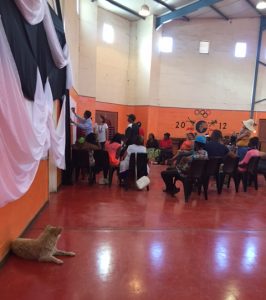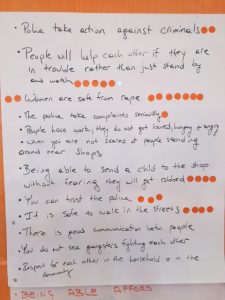Where’s the reconciliation?
by Roger Mac Ginty.
December 16 is South Africa’s national reconciliation day. I am just back from a trip there and I was struck by the absence of reconciliation in everyday life. As ever, a short trip in a massive and varied country only affords a snapshot (I was in the Western Cape and I am sure that the picture might be better in other areas). So the following views by an outsider are to be taken with a strong health warning. Facilitated by the wonderful Institute for Justice and Reconciliation (IJR) in Cape Town, I was able to hear – first hand – from members of black and coloured communities about their everyday experiences in post-apartheid South Africa. This was part of the Everyday Peace Indicators project where we seek to crowd-source people’s everyday indicators of peace, security and safety in the areas where they live.
For me, as a first time visitor to South Africa, the most striking observation was the continuation of apartheid. It is no longer enshrined in law, but its effects are visible to see in segregation in almost every sphere of life: where people live, what they do for a living (if they have a job), their access to services, their life opportunities, and the absence – as far as I could see – of inter-racial relationships. People in black townships reported that they never see a white person where they live. In one focus group meeting, a man said to my colleague Pamina Firchow, ‘A [white] farmer would not sit next to me as you are sitting next to me’. It is worth noting, this is two decades after apartheid.
In our focus group meetings people talked about two linked topics: the lack of employment and crime. The economy is flat-lining and there is little social mobility. The much talked about ‘black middle class’ is tiny. The real story is the huge number of black and coloured communities who have simply been left to get on with life. They may be protected in law, but they do not feel protected by it. Testimony from person after person built up a picture of shockingly sustained level of crime: petty theft, violent robbery, gang shootings and rape. People discussed crime in a blasé and de-sensitised way. They felt that the police were either under-resourced or sometimes in cahoots with criminals.
South Africans have suffered from multiple disruptions that have eroded social capital (or the ability of families and communities to cope): apartheid displaced millions and produced a highly racialised society. People who had lived in traditional social systems were herded into shacks cut off from the social and cultural hinterland that allowed them to survive. A rapid series of disruptions have followed: a violent end to apartheid, economic shocks (including the ending of subsidies that supported many jobs), and the spread of drugs, guns and gangs.
To a large degree, those whites that can afford it have managed to survive a reasonably privileged life – still playing a prominent role in the professions and owning the best land. There has been no land re-distribution (and it is difficult to see how this could occur in a way that would be managed and sustainable). Reconciliation – to the extent that it took place – has stalled. It is difficult to see what the next stage might look like without some form of recognition of the need for restitution – or a compensating of the black and coloured communities for the massive structural inequalities they face. This brings us into uncomfortable territory because it might mean the diminution of white privilege: the giving up or taking away of some of the things they have.
But rather than thinking of restitution in a material sense, it might be worth thinking about it in a more systematically symbolic sense – the voluntary acknowledgement by white individuals and communities of their historical privilege: a voluntary, visible and loud atonement. Such a move would take immense bravery and many in the white community would baulk. People abandoned in a township may well say that such symbolic acts will not get them jobs or allow them to escape the shadow of crime. But graciousness and some sense of allyship – however symbolic – seems to be missing from the equation. It is a low cost but potentially high impact step that could – for example – occur on the national day of reconciliation. Perhaps white individuals and groups could come to town centres and offer contrition in a public way. Perhaps each year they could drop a pebble in a pond. Cumulatively, the pebbles could build up. It sounds crazy, but sometime crazy things work.
But unilateral white restitution is not enough. There is another group that should join them on the kneeler: the ANC government. Post-Mandela, the government has been asleep on the reconciliation agenda. For restitution to work, it could do well to recognise that the government has wasted ten years on attaining the foibles of power without delivering the goods, services and jobs that people want. Truly, sorry is the most difficult word.





0 Comments